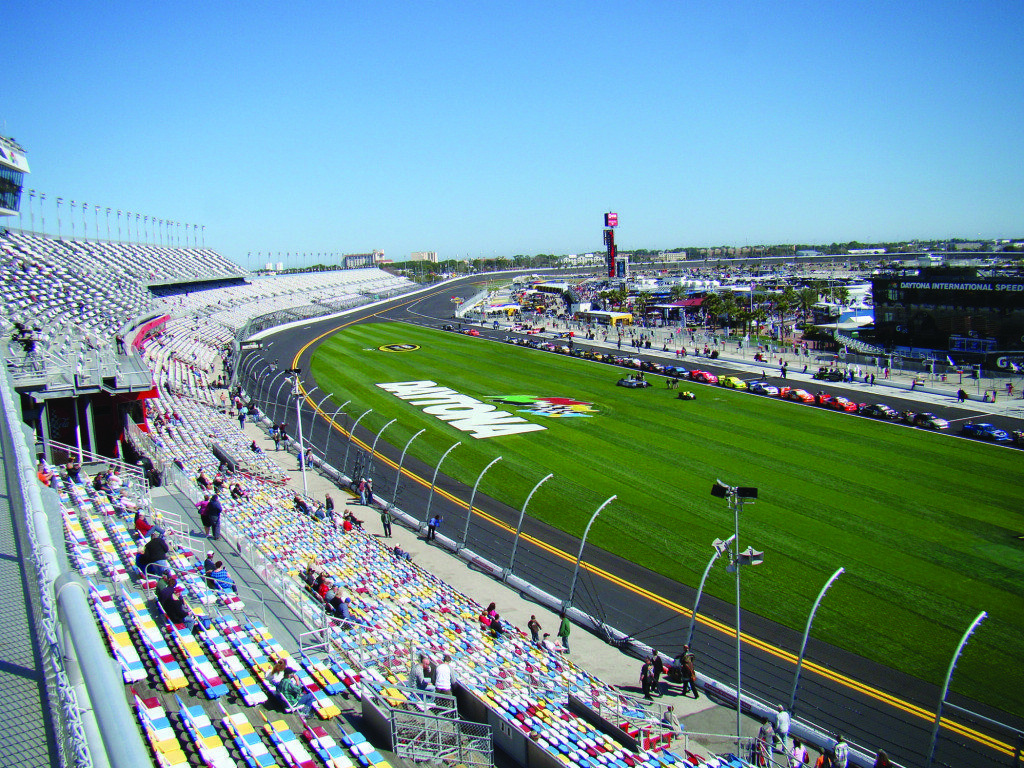 Daytona 500 retains pride of place in NASCAR
Daytona 500 retains pride of place in NASCAR
The week after the Super Bowl, capping the football season, will see the 58th running of the Daytona 500, starting the NASCAR season. There is an affinity between the two spectacles, which draw unparalleled attention in their respective sports.
“Daytona is like the Super Bowl of NASCAR,” said Tonya Clarkston of Charlotte, NC, who worked with a NASCAR-affiliated licensing agency. “It’s where the sport was founded, where the first major races took place. There is so much history tied to the Daytona Beach area.
“It’s one event that pulls in the most TV coverage, draws the casual fan and gets quite a bit of celebrity acknowledgment,” she added.
Clarkston noted that stock car racing’s roots go back to the bootleggers and moonshiners in the southern regions who distributed their liquor in cars. They began to modify their vehicles, and drove “fast and furious” to evade law enforcement. Many translated this enthusiasm to road and track racing.
At the same time, Daytona Beach was drawing a reputation where automobile land speed records were being made. One of those who raced on the sands was a transplant from Washington, DC, Bill France Sr. In 1948, wishing to bring order to the chaos of stock car racing, he and others founded the North American Stock Car Association.
Among the organizers present “at the creation” was Bob Sall of New Jersey, a top sprint car driver in the 1930s. Sall became manager of NASCAR’s eastern operations. His nephew Glenn Sullivan of Westbury is now retired from a career on the speed tracks, but retains a link as a trainer of aspiring racers.
Before the opening of the Daytona International Speedway in 1959 (coinciding with the inaugural Daytona 500), he related, races were held on the beachfront track, whose only paved portion was State Highway A1A.
 “Sometimes the high tide would come in and they would get stuck in the water,” Sullivan said of the early racers.
“Sometimes the high tide would come in and they would get stuck in the water,” Sullivan said of the early racers.
Sullivan, 55, attended his first Daytona 500 in 1969, taking the train from Penn Station with his parents. He began racing at local tracks—Freeport, Islip, Riverhead—before making his way up the racing circuit. From 1991-2007 Sullivan started well over 100 races in the NASCAR Busch (now Xfinity), NASCAR K&N Pro, ARCA Racing and X-1R Pro Cup series. He was part of Bobby Allison’s team during his Busch era. “I lived with the family and Davey (later killed while attempting to land his helicopter) was my best friend,” he said.
Through his Sullivan Motor Sports and association with KAMO Motor Sports he trains and guides young drivers. But Sullivan, who will be heading for his annual trip to the big race, said that he finds one trend disappointing.
“It’s a different world,” he said of NASCAR. “It’s so much money—you need millions to get near it. It’s not so much about driving ability as how much money you have. It’s a shame. It’s not what my uncle and Bill France wanted it to be. They [formed NASCAR] for the betterment of the drivers.”
Still, Sullivan noted, NASCAR must be doing something right.
“It’s been the number one spectator sport in the world the past 30 years,” he said.
NASCAR has international affiliations and, according to Clarkston, “is trying to market to a younger generation, the 20-28 age group.
“It goes to the heart of America. It’s enduring,” she said of the sport.
About The Race…
The flag will drop at 1 p.m. on Sunday, Feb. 21, for the 58th annual event. Fox will provide televised coverage. If you plan to attend in person, tickets start at $95 and two- and four-day packages are available. Visit www.daytonainternationalspeedway.com. According to the website, “Wider seats, upgraded amenities, and unmatched sightlines make for a more immersive experience at racing’s richest tradition.”
































